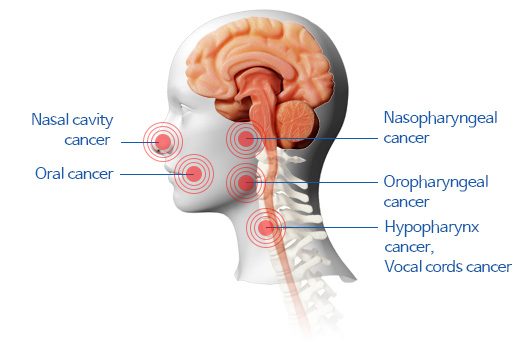
Proton therpay for head and neck cancer
We would like to introduce the details of proton therapy for head and neck cancer.
- 01.
- In which cases of head and neck cancer can proton treatment be applied?
- Proton treatment can be applied to most head and neck patients including patients with nasopharyngeal cancer, oropharyngeal cancer, oral cancer, laryngeal cancer, and salivary gland cancer.
- Especially, significant effects of the treatment can be expected with adenoid cystic carcinoma and after radiotherapy, proton treatment can be applied to treat recurrent cancers.
- Other than this, after the X-ray radiotherapy has been facilitated, proton treatment can be applied to boost treatment for residual cancer or sites with a high risk of recurrence in the last process of radiotherapy.
- 02.
- What is the advantage of the proton treatment when applied to head and neck cancer patients?
-
The head and neck regions have essential important organs such as the eyeballs, optic nerves, optic chiasm, mesencephalon, myelencephalon, cochlea, and various types of cranial nerves, salivary glands, and mucous layers. Therefore, side effects can occur due to accumulation of radiation transferred to such essential important organs while implementing radiotherapy for head and neck cancer. Side effects can significantly influence the patients normal life cycle and it can be the main cause of a decrease in one’s quality of life, and in some cases, it can lead to severe after-effects.

[Proton therapy for cancers near the head and neck]
- Although the level of radiation exposure transferred to the normal tissues can be decreased with Intensity Modulated Radiotherapy, if brain penetration is accompanied with the nasal cavity, paranasal sinuses, and nasopharyngeal cancer, it may be difficult to avoid radiation exposure to the eyeballs, neurosis, mesencephalon, and myelencephalon. This can lead to failure of tumor removal or side effects from radiation including lose of optic functions and brain necrosis. Furthermore,, the distribution of medium-low radiation dose during the intensity modulated radiotherapy may be the main cause of mucositis and xerostama.
-
Proton treatment, in comparison to the intensity modulated radiotherapy, has the advantage of minimizing radiation exposure to the important organs nearby while transferring a sufficient level of radiation to remove tumors. In addition, the side effects in mucositis and xerostama can be decreased due to a reduction in the amount of medium-low radiation, compared to X-ray radiotherapy.

 [Proton Therapy compared to the X-ray treatments to treat head and neck cancer]
[Proton Therapy compared to the X-ray treatments to treat head and neck cancer]
- 03.
- What are the effects of the treatment?
- In systematic literature reviews and meta-analysis reports, it has been reported that proton treatment displayed better treatment results than the existing X-ray radiotherapy in treating head and neck cancer patients. It has been reported in various clinical studies that proton treatment can preserve eyesight and decrease possibilities associated with xerostama and development of secondary cancer. Moreover, it is being reported in the treatment scheme comparative analysis studies that proton treatment, by minimizing medium-low radiation exposure, can help improve the quality of life of head and neck cancer patients.



